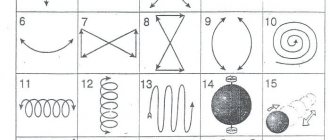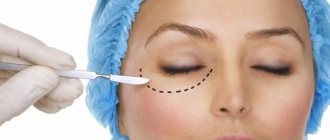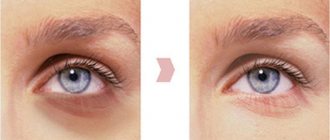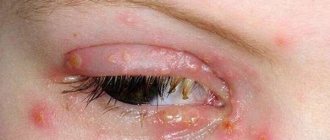Eyes are the mirror of the soul. Healthy eyes without red streaks give a person confidence. The organs of vision are sensitive not only to external stimuli and are sensitive to changes in health. They are equipped with a lacrimal apparatus that protects the eyes from other foreign bodies. The appearance of a little tearfulness is perceived as a completely natural phenomenon.
The appearance of unpleasant sensations, redness and itching along with tears should alert you. Many people do not pay attention to such symptoms, but in vain. The ophthalmologist is provided with the diagnostic results, after which the diagnosis and treatment are announced.
The causes of pain and tearing of the eyes can be trivial, or they can hide serious diseases affecting internal organs. Diagnostics and examination by a specialist are necessary to make a diagnosis and correct treatment.
Conjunctivitis
Inflammatory processes occurring on the mucous membrane of the eye are called conjunctivitis. The causative agents of the disease are bacteria, viruses, fungi, and allergens.
There are two stages of development of the disease: acute and chronic. In acute conjunctivitis, the patient experiences:
- Headache;
- Heat;
- Weakness and malaise.
Often, having appeared in one eye, inflammation spreads to the other. This becomes the main problem of the disease.
The course of eye disease depends on what causes it. Treatment is adjusted accordingly.
Bacterial conjunctivitis
The formation of infectious conjunctivae is caused by exposure to staphylococci, diphtheroids, propionibacteria and other pathogenic microorganisms. The disease occurs in both children and adults.
The disease is infectious and occurs in an acute form, with the release of pus, mucus, and lacrimation. At the same time, the eyelids swell and stick together due to pus. If symptoms appear, you should immediately contact a specialist. It is important to maintain hygiene during the treatment process. Since conjunctivitis is a contagious disease, you should use a separate towel.
Before using medications, you must rinse the infected eye and remove any discharge. A separate swab is used for each visual organ.
To treat viral conjunctivitis, eye drops with an antibacterial effect are prescribed:
- Floxal drops. The active ingredient is ofloxacin. The prescribed drug affects pathogenic bacteria: E. coli, streptococcus, etc. The effect of the drug appears after 10-15 minutes. Duration of effect is 6 hours. Almost complete absence of side effects.
- Tobrex. A substance that is part of the drug and does not actively affect bacteria is tobramycin. It has a wide spectrum of action against pathogenic infections. The course of treatment lasts 7 days. The eyes may react to the medicine: redness, swelling and pain.
- Levomycetin. Antimicrobial agent. Suitable for combating a wide range of harmful microorganisms. The action of the drug is aimed at blocking bacterial protein synthesis. Levomycetin is instantly absorbed into the blood. Side effects such as allergies are possible. Long-term use of the drug is not recommended; disturbances in hematopoietic function and a decrease in leukocytes and platelets are possible.
Chlamydial conjunctivitis
Inflammation of the mucous membrane caused by chlamydia. An intracellular organism that has the properties of bacteria and viruses. They are inside the cell in an inactive state, but continue to parasitize. When immunity decreases or other favorable conditions occur, the infection awakens and actively multiplies.
Treatment of chlamydial conjunctivitis occurs with antibiotics: fluoroquinolones, macrolides, tetracyclines. Eye drops:
- Ofloxacin solution. Antibacterial agent with a wide spectrum of action. Affects bacterial DNA, leading to destabilization of bonds and death of the microorganism.
- Ciprofloxacin solution. An antimicrobial drug that acts on the DNA of pathogenic microorganisms. The effect of the medicine extends not only to active infections, but also to those in the inactive phase.
- Tetracycline ointment. Pharmaceutical agent with bactericidal action. The ointment is applied to a clean bandage and applied to the infected eye. Change the bandage three times during the day.
- Dexamethasone. Antiallergic and anti-inflammatory medicine. The active substance included in the composition begins to act immediately and lasts up to 8 hours. The drug has proven itself in the fight against eye inflammation if there has been an injury or debris has gotten into the eye. Place 1-2 drops into each visual organ. The course of treatment is calculated individually by the doctor, but not more than 14 days.
Fungal conjunctivitis
Ophthalmomycosis caused by the action of pathogenic fungi. Depending on the type of fungus, the disease is accompanied by purulent inflammation. The appearance of a film, nodular formations with lymph and blood on the mucous membrane of the eye is observed.
Before starting treatment, a laboratory analysis of a smear of discharge is carried out and the type of fungal microorganism is determined. Local and systemic treatment of the disease with antifungal drugs is carried out:
- Amphotericin B. Effective eye drops with antifungal action.
- Nystatin drops and ointment.
- Fluconazole.
Causes
Among the causes of increased lacrimation, two main ones can be distinguished: obstruction of the lacrimal ducts and increased production of tear fluid.
Blocked tear ducts
Blocked ducts become the most common cause of tearing in adults. This is an acquired condition, but congenital underdevelopment of the lacrimal ducts also occurs. Often, increased tearfulness occurs in newly born babies. This is due to the fact that the ducts may not be sufficiently formed. Tearfulness goes away within two to three weeks.
In adults and adolescents, increased tearing most often occurs due to narrowing of the ducts or when they are blocked. Narrowing of the tear ducts usually occurs as a result of swelling or inflammation. If the ducts are narrowed or blocked, tears will not be able to drain and will accumulate in the lacrimal sac.
Stagnation of fluid and the lack of its dynamics contribute to an increased risk of inflammation and infection. The eye then secretes a sticky secretion, which makes the problem worse. Since the eye and nose are connected by a canal, inflammation can spread to the nose from the side of the affected canal. As a result, the drainage system, which itself is narrow, swells and becomes impassable. Subsequently, swelling, inflammation and further tissue scarring occurs.
Increased production of tear fluid
When there is pain in the eyes, more tear fluid may be produced than necessary. This is due to the fact that the body is trying to get rid of the irritating substance. The following reasons can lead to pain and tearfulness:
- some chemical agents, including gaseous ones;
- food products such as onions;
- conjunctivitis: bacterial, viral, allergic origin;
- mechanical damage or ingress of a foreign body, dust;
- trichiasis is a condition when eyelashes grow not outward, but towards the mucous membranes of the eyes;
- ectropion is a pathology in which the lower eyelid turns out.
The structure of the lacrimal gland
Episcleritis
Inflammatory process in the tissues located between the mucous membrane and the apple of the eye. It does not occur independently, but is a consequence of other diseases: gout, rheumatoid arthritis, lupus erythematosus, tuberculosis or ulcerative colitis.
Accompanied by symptoms:
- Tearing;
- Eyes become very red;
- Pain syndrome;
- Feeling of pressure on the eye;
- Heaviness.
Patients exhibit external signs: discharge and fear of light. Episcleritis is often confused with conjunctivitis. A professional doctor will be able to make the correct diagnosis and prescribe adequate treatment. Depending on the type, the disease process lasts from two weeks to a month.
No special treatment is required, just follow the doctor’s recommendations:
- Avoid overexertion;
- The eyes should get plenty of rest;
- If pain occurs, use a medicine with the effect of artificial tears;
- Taking anti-inflammatory drugs.
Tears are a sign of hidden infections
“In the cold, some hidden problems worsen, and lacrimation occurs. A person should not neglect such signals; he should consult a doctor,” reminds Dmitry Davydov. “An ophthalmologist will establish an accurate diagnosis. And only after that he will prescribe the appropriate type of treatment. The doctor examines the anterior segment, assesses the condition of the cornea, limbal zone, conjunctiva, and eyelids. Perhaps a person has a bacterial or viral infection, and older people may also have tick-borne manifestations in the form of demodex. The doctor will professionally figure out what the root cause of the patient’s complaints is.”
Question answer
For what reasons can eyes turn red?
Also, lacrimation in the cold can be caused by ARVI. This is explained by the connection of the nasolacrimal ducts with the nasal cavity. Therefore, during various colds (flu, sore throat, acute respiratory viral infections and acute respiratory infections), the swelling of the nasal mucosa increases and the amount of tears increases.
Vitamin deficiency can also lead to watery eyes. Lack of vitamins, micro- and macroelements also affects eye health. They “weaken” and cannot quickly adapt to environmental changes - frost and wind.
Thus, the main thing to pay attention to when watery eyes appear in the cold is how long the tears last. If they go away after a few minutes of being in the cold, there is no cause for concern; it is simply a protective reaction of the eyes, which adapt to external weather conditions. But if tears constantly flow not only on the street, but also indoors, you need to find out the reason and consult an ophthalmologist.
Iridocyclitis
With the disease, inflammatory processes occur on the iris of the eyes and on the eyelids in the eyelash area. Iridocyclitis accompanies:
- Redness of the eye;
- The appearance of swelling and pain;
- Tearfulness;
- It hurts to look at the light;
- The pupil narrows and becomes deformed;
- The quality of vision decreases;
- The color of the iris changes.
The following medications are used for treatment:
- Prednisolone and Hydrocortisone. Designed to combat a nonspecific form of the disease. They have anti-inflammatory properties, the ability not only to treat, but also to prevent the disease from progressing to a severe form or the occurrence of complications.
- Broad-spectrum antibiotics. The doctor prescribes it after diagnosis.
- To dilate the pupil. Used: Mydriacyl, adrenaline, Diclof, etc.
Nervous disorders, stress
The eyes and nervous system are closely interconnected. Stressful situations or severe nervous shock can cause psychosomatic symptoms: the eyes begin to hurt from the inside, tears are released profusely.
Since the causes of external manifestations lie in the nerves, it is necessary to take sedatives prescribed by a specialist.
If you change your lifestyle and pay more attention to your own health, then problems that arise in the visual organs can be corrected and prevented.
Wearing lenses
Incorrect selection of contact lenses, poor care of the device, violation of wearing rules - leads to redness of the eyes, tearing, burning and pain.
Depending on the material, contact lenses cannot be worn for more than 15 hours at a time. It is also necessary to clean the equipment in a special disinfectant solution every night.
There are daily contact lenses. They are worn during the day, after removal they are thrown away and new ones are put on in the morning. Not everyone can afford to purchase them.
To eliminate the symptoms of improper lens wear and to maintain eye health, you must follow the rules for caring for the device: do not wear it for a long time, wipe it with a special solution, and leave it in the solution overnight.
The problem of watery eyes and pain in the eyes occurs when the patient wears glasses. Unpleasant sensations occur when wearing lenses of inappropriate power. By changing glasses, you can restore your health and relieve pain symptoms.
Allergy
The body exhibits a specific reaction to the appearance of irritants in the environment: fluff, dust, wool, pollen, cosmetics, household chemicals. In this case, symptoms appear: redness, swelling, watery eyes, itching.
As a rule, allergies are a seasonal disease that worsens in spring and summer, when there is a period of active flowering. The specific reaction to fur, dust, and mites is constant throughout the year.
Diagnostics are necessary to establish the cause of eye pain and determine the causative agent of the allergic reaction. The procedure is performed by a doctor, a diagnosis is established, and medications are prescribed:
- Antihistamine action. Medicines block the body's receptors that are responsible for the release of elements that cause an allergic reaction in the body. Zodak, Tavegil.
- Decongestants. Eye drops to relieve allergic swelling: Cromohexal, Lecrolin, Opatanol.
- Anti-inflammatory. Reduce inflammation and relieve swelling of soft tissues.
- Vasoconstrictors. Medicines are prescribed to relieve redness by constricting the blood vessels that supply oxygen to the visual organs. Visin, Octilia, Okumetil. Long-term use of these medications is not advisable. Possible addiction and the effect of use decreases.
Allergic reactions
Often, lacrimation occurs due to specific reactions of the body to external stimuli. These can include chemicals, pollen, certain foods, pet hair, etc. Often, watery eyes in such situations are accompanied by redness of local tissues, the formation of a persistent sensation of itching, and frequent sneezing.
To eliminate the release of an abundance of tear secretion and stop the allergic reaction, doctors advise resorting to medication to solve the problem. We are talking about the use of antihistamines. It is important to limit contact with potential allergens.
Injury
There are different types of eye injuries:
- Mechanical. Impact from a hard or blunt object. Internal hemorrhage and dissection occurs. The area around the eyes swells, the eye becomes red and watery.
- Chemical. Contact with alkaline agents or acids leads to significant damage to the mucous membrane.
- Thermal. Boiling water or hot steam can cause thermal burns to the eyes.
- Ray. Radiation exposure can lead to the formation of malignant tumors in internal organs.
The injury is accompanied by symptoms: redness and pain, decreased quality of vision, production of tears, and fear of light.
The treatment process depends on the nature of the damage received. Mechanical trauma associated with dissection of the eyebrow or eyelid is treated with surgery: wound treatment and suturing. For milder injuries, it is necessary to treat with medication, by instilling drops with an antimicrobial effect.
Dry eye syndrome
Tear film dysfunction. As a result, insufficient moisture is produced on the surface of the eye from the tear ducts. In this case, the eyes may hurt and water, and there is a feeling of sand under the eyelids. The disease is associated with a violation of the integral structure of the film or disruption of the glands responsible for the production of tears. Occurs after sitting for a long time at a computer monitor or watching TV.
To eliminate unpleasant symptoms, drugs based on artificial tears are instilled into the eyes: Visine.
Treatment
If the cause is a disease, drug treatment is used:
- antibacterial therapy;
- antiviral agents;
- non-steroidal anti-inflammatory drugs;
- antihistamines.
If the condition is caused by mechanical damage, the doctor removes the foreign object and instills an antibacterial substance.
If increased tear production is caused by eye sensitivity, ophthalmologists recommend purchasing high-quality sunglasses. The higher the degree of protection, the less impact there will be on the surface and internal structure of the eyes.
What can you do at home when your eyes hurt?
You need to remember what to do at home to save your visual system:
- Pull out the foreign body yourself, if possible.
- Give your eyes a rest after working at the computer for a long time.
- In case of allergic reactions, take antihistamines as prescribed by your doctor.
- When swimming in salt water, rinse your eyes with mineral or plain drinking water.
- If your eyes feel dry, use medications based on artificial tears.
Medicines are taken only after consultation with a doctor and a correct diagnosis.
Why the eye may become red and watery
If you notice that one of your eyes is watering, the first questions that may arise are what to do, how to treat and what to treat. However, the first thing that needs to be done is to treat lacrimation by eliminating associated irritating factors that may cause it.
We recommend!
To treat eyes without surgery, our readers successfully use a proven method. Having carefully studied it, we decided to offer it to your attention. Read more…
For example, if one eye is red and watery, then you need to check whether a foreign body in the form of an eyelash or other debris has entered it. If all blockages are excluded, then tearing may be a sign of some serious disease, which only a doctor can determine. This is due to the fact that any alarm signals from the body and directly from the organs of vision are not a joke and it is strictly forbidden to let this process take its course.
If there is very strong redness of the eyeball, this is due to the fact that inflammation of the vascular formations that are located inside the sclera has occurred. In a calm state, these vessels are practically invisible, and the sclera has a characteristic white color. The reasons that precede redness can be both internal and external. External reasons. In this case, swelling and inflammation of the eyeball may be preceded by the following negative factors:
- negative environmental impact;
- entry of foreign bodies;
- exposure to contact lenses;
- allergic reactions, lacrimation, the treatment of which is reduced to eliminating allergens;
- traumatic conditions of the cornea;
- inflammation of the optic nerve.
Internal factors. These are reasons, of which there are relatively many. Almost all pathological processes that occur in the human body can become precursors to vision problems and eye inflammation. These problems can be cured and eliminated by eliminating the underlying disease that affects vision. In such situations, the redness usually spreads to both eyes, although a unilateral process can sometimes be observed.











